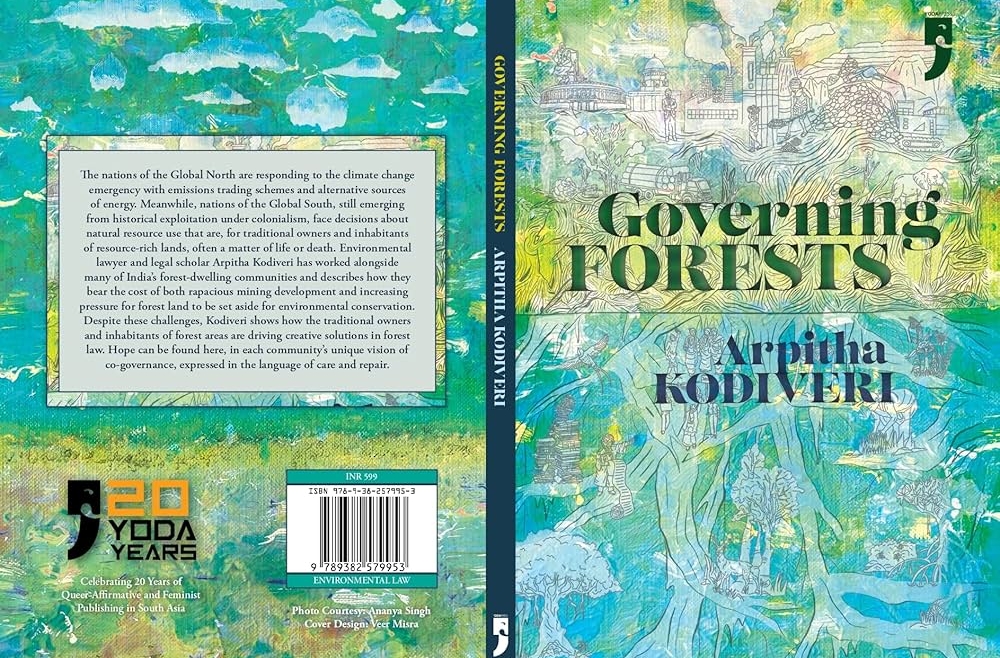India’s forest laws are often the bone of contention between the state and the forest-dwelling communities. In her book, Governing Forests, Arpitha Kodiveri covers the legal struggles and successful social movements of Adivasi communities based on her seven years of experience as an environmental lawyer supporting the tribal people.
In this conversation with Monisha Raman, Arpitha talks about decolonising environmental laws, the effects of extraction economy and the burden on Indian forests.
There is this whole movement on decolonisation and yet you see remnants of colonisation in India’s environmental laws. Do you think the Forest Rights Act was the country’s only decolonial milestone (with regard to environmental laws) in all these years of independence?
This is a fascinating question. When we examine the history of environmental law in India, and indeed in other post-colonial countries, we see clear remnants of colonial legislation in the way forests and natural resources are governed. A central legal concept that shaped post-colonial choices was sovereignty over territory and natural resources, which was seen as essential to nation-building. This was echoed in international law through the doctrine of permanent sovereignty over natural resources. I begin with this history to highlight that environmental law in the post-colonial moment has largely been defined by the assertion of sovereign control over resources. The democratisation of environmental decision-making emerging only slowly and unevenly much later.
Colonial forest laws were retained in independent India because they reinforced centralised state control and power over how resources could be used, echoing the need for a young nation to begin the project of nation-building. Forest-dwelling communities were left with little space to shape these decisions. This colonial continuity entrenched legal structures that privileged the state and corporate interests while marginalising the customary claims and ecological knowledge of forest-dwelling communities.
Before the passage of the Forest Rights Act (FRA) in 2006, there were multiple legal attempts to democratize forest governance—such as the introduction of Joint Forest Management programs and the recognition of community reserves under the 2002 Wildlife Protection Act amendment. Yet these reforms either went unimplemented or maintained the state’s hold over decision-making, often reducing community participation to symbolic involvement.
Seen in this light, the FRA is not a decolonial milestone, but it is an important step in that direction. It seeks to undo the historical dispossession of forest dwellers through legal recognition of their rights. However, as I argue in the book, the FRA remains caught in a web of contradictory legal frameworks. Its passage was not accompanied by corresponding amendments to the Indian Forest Act or the Wildlife Protection Act. As a result, its implementation has been shaped by interpretation battles within the forest bureaucracy, which often selectively applies or undermines the law. The ongoing contestation around the FRA reveals both the potential and the limits of legal reform as a decolonial tool in India’s environmental governance.
The narrative of Governing Forests takes an unbiased approach to what you witnessed. How did you silence the activist’s voice while writing it, especially while covering the injustice meted out to the minority communities dependent on forests?
Thank you for this question. When writing, I was less concerned with appearing unbiased than being transparent about my standpoint. My entry point into these forested landscapes was as an environmental lawyer, working alongside forest-dwelling communities to implement the Forest Rights Act (FRA). Later, I returned to some of these areas as a researcher, seeking to understand how the law was being interpreted, contested, and mobilised by these communities in their everyday struggles.
This dual role, as both practitioner and researcher, shaped how I approached the book. My perspective is deeply informed by my time supporting communities in their legal battles and by my attempts to grapple with the realities of how laws unfold on the ground. What became clear during fieldwork is that forest-dwelling communities, living daily within the contradictions of laws structured by extraction and dispossession, were not simply passive recipients of injustice but astute legal thinkers, strategists, and political actors. They craft sophisticated arguments, reinterpret legal provisions, and deploy creative tactics to reclaim power, assert sovereignty, and reshape their relationships to forests.
This learning deeply influenced my writing. Rather than focusing solely on suffering, I tried to foreground how communities themselves narrate their struggles, using their own legal vocabularies and frameworks of justice, while highlighting the ways they are actively reshaping the law and reimagining their futures from within these contested spaces.
You mention the shortsightedness of lawmakers who think afforestation elsewhere gives the state the right to cut down trees. As any environmental lover knows, forests are not just a bunch of trees. It is a beautifully intricate living ecosystem and each species has a role to play. Given this kind of lacuna, do you think it is appropriate to put the carbon sequestration burden on the forests to combat climate change?
I think the current moment in environmental law is defined by what I have come to identify as a compensatory approach. In the 1970s, the early development of environmental laws, globally and in India, was guided by the precautionary principle, or the idea that potential harm should be prevented before it occurs. Yet in practice, implementation often tilted toward permission: projects were allowed to proceed so long as they secured environmental or forest clearances with certain conditions attached.
A significant shift occurred in the 1980s and crystallised with the Kyoto Protocol in 1997, which introduced carbon markets and the notion of offsetting emissions. This marked a turn from prevention to compensation: a logic where ecological destruction is permitted on the assumption that it can be recreated or repaired elsewhere. In India, this logic is institutionalised in the Compensatory Afforestation Act of 2015. The law effectively creates a legal pathway for permitting harm under the guise of ecological restoration, moving us from a framework of preventing harm to one of post-harm repair. Yet the science on afforestation remains deeply ambiguous: can newly planted trees truly replace the complex ecosystems lost?
This compensatory logic not only facilitates extraction but also sidelines the rights and knowledge of forest-dwelling communities. By framing forests primarily like carbon sinks or sites for offsetting, the law risks erasing the lived realities and custodianship of the people who inhabit them. At the same time, there may be empowering possibilities in recognising the role forests play in carbon sequestration if, and only if, it is deployed as a legal tool to prevent deforestation and to strengthen the rights of forest-dwelling communities to conserve and govern these landscapes. I am speculating here, but such a shift could help move environmental law away from its compensatory orientation and back toward a genuinely precautionary approach, one that both protects ecosystems and affirms the rights of the communities who have lived and depended on them.
With governments prioritising the extraction economy, do you think there is hope for the tribal communities? Or do you think we need a complete reform of our forest laws and a whole new approach prioritising indigenous knowledge?
I do think there is hope for forest-dwelling communities, and I say this from what I have learned in the field and through my conversations with community members and activists. As we navigate the climate crisis, it is tempting to give in to despair. Yet, as many of my interlocutors have reminded me, hopelessness is itself a form of privilege. For those on the frontlines, hope is not a passive sentiment but an act of solidarity—embodied in the daily work of repairing relationships with the planet and fighting for justice in the face of adversity.
What gives me hope are the acts of resistance that continue despite the systematic deregulation and erosion of environmental protections since 2014. For instance, forest-dwelling communities forcibly evicted from the Nagarhole Tiger Reserve have, after forty years, returned to their ancestral lands and are now asserting their rights under the Forest Rights Act (FRA). Similarly, the sustained pressure of climate and environmental organisations stalled the draft Environmental Impact Assessment (EIA) notification in 2020. And in 2021, the Supreme Court’s decision in Vanashakti v. Union of India struck down the practice of ex post facto clearances, affirming that the EIA process is crucial to preventing irreversible harm.
Of course, challenges remain. Progressive frameworks such as the FRA continue to face threats of dilution, deregulation, or non-implementation. The Indian Forest Act and the Wildlife Protection Act still need to be amended to harmonise with the rights-based vision of the FRA, and new laws are urgently required to confront the realities of the climate crisis. Hope lies not only in legal reforms but also in the ways communities themselves reshape the meaning of law through everyday acts of resistance and creativity. As I show in the book, forest-dwelling communities are not simply defending their rights but advancing alternative visions of governance, sovereignty, and ecological care. It is in these struggles, where law is contested, reimagined, and reclaimed, that the possibility of a more just and sustainable future may emerge.
What do you think is the role of an environmentally conscious citizen in the Anthropocene?
I can speak to this from my perspective as both an environmental lawyer and a researcher. To meet the challenges of the Anthropocene, we need greater and more imaginative mobilisation of the law. This includes going before the courts, training and supporting the next generation of environmental and climate lawyers, and working within bureaucratic structures to push for more accountable and ecologically grounded decision-making.
The law is a site of regulation and a terrain of struggle and possibility. Communities and activists use it strategically sometimes to resist dispossession, sometimes to carve out new spaces of sovereignty and a politics of care towards our planet. Engaging with the law is not just about compliance or litigation; it is about reshaping what justice can look like in an era of ecological crisis. The task ahead is to deepen these mobilisations so that law becomes a vehicle not for extraction but protection, repair, and solidarity.
Having all this insight into the system that takes a totalitarian approach when it comes to the resources and citizens who depend on them, have you thought of carrying this experience into fiction?
I have been contemplating writing fiction for some time and am now experimenting and working on my first piece of climate fiction. It explores the dilemmas of a lawyer who is called upon to represent the interests of coral reefs considered sacred by indigenous peoples as they are threatened by marine heatwaves and the looming pressures of deep-seabed mining. Through this story, I want to examine how law might be mobilised to limit speaking for ecosystems themselves, raising questions about justice, representation, and legal responsibility in the Anthropocene.

Arpitha Kodiveri is an environmental law and justice scholar whose work focuses on the role of law in the context of redressing climate harms faced by indigenous communities in South Asia. She has worked as an environmental lawyer supporting Adivasi and forest-dwelling communities in India. She is currently an assistant professor of political science at Vassar College.
Monisha Raman’s debut, The Highlands of Yore, is forthcoming with Readomania and Running Wild Press. Her essays and stories have appeared in several journals and anthologies.



